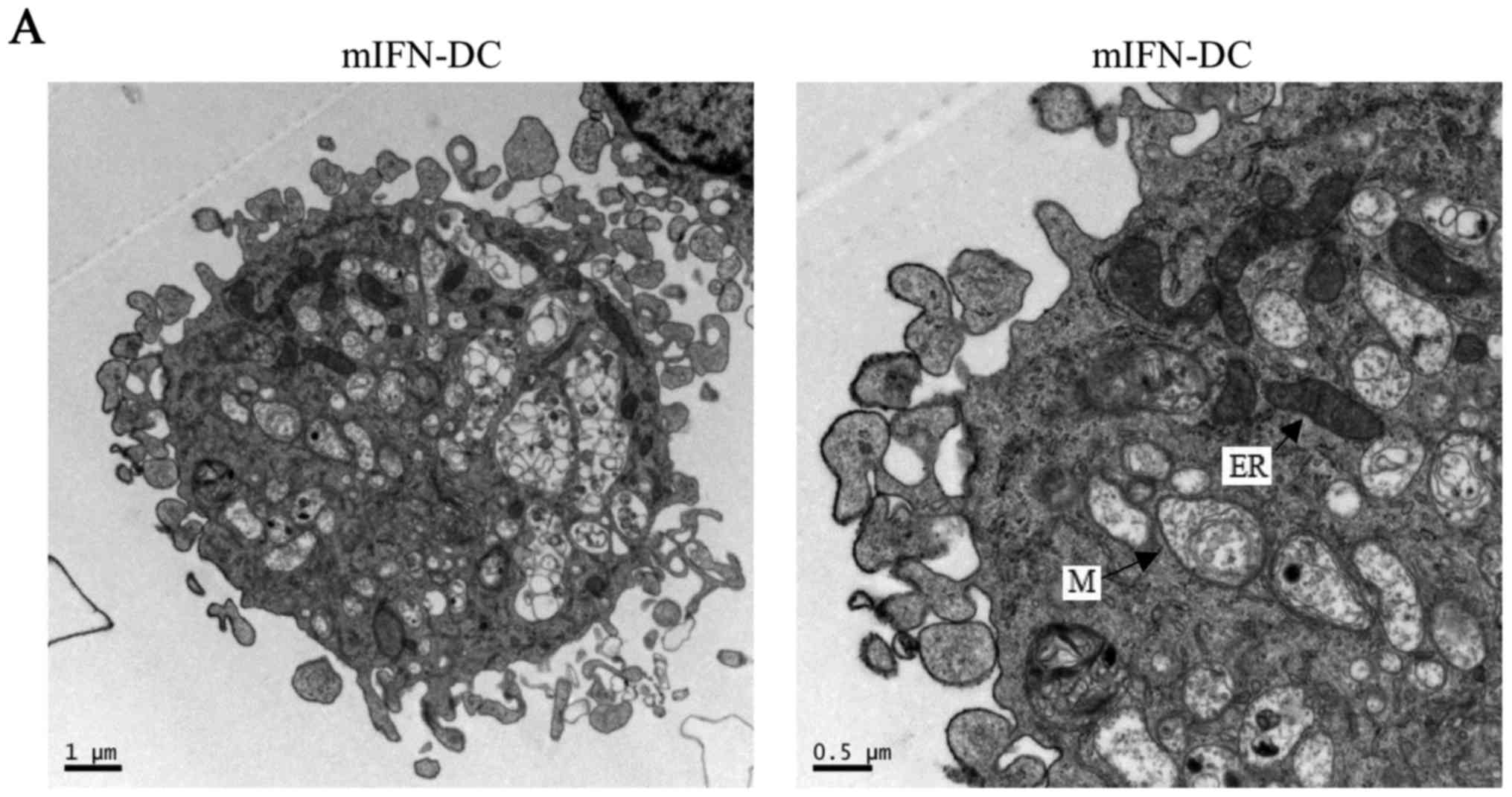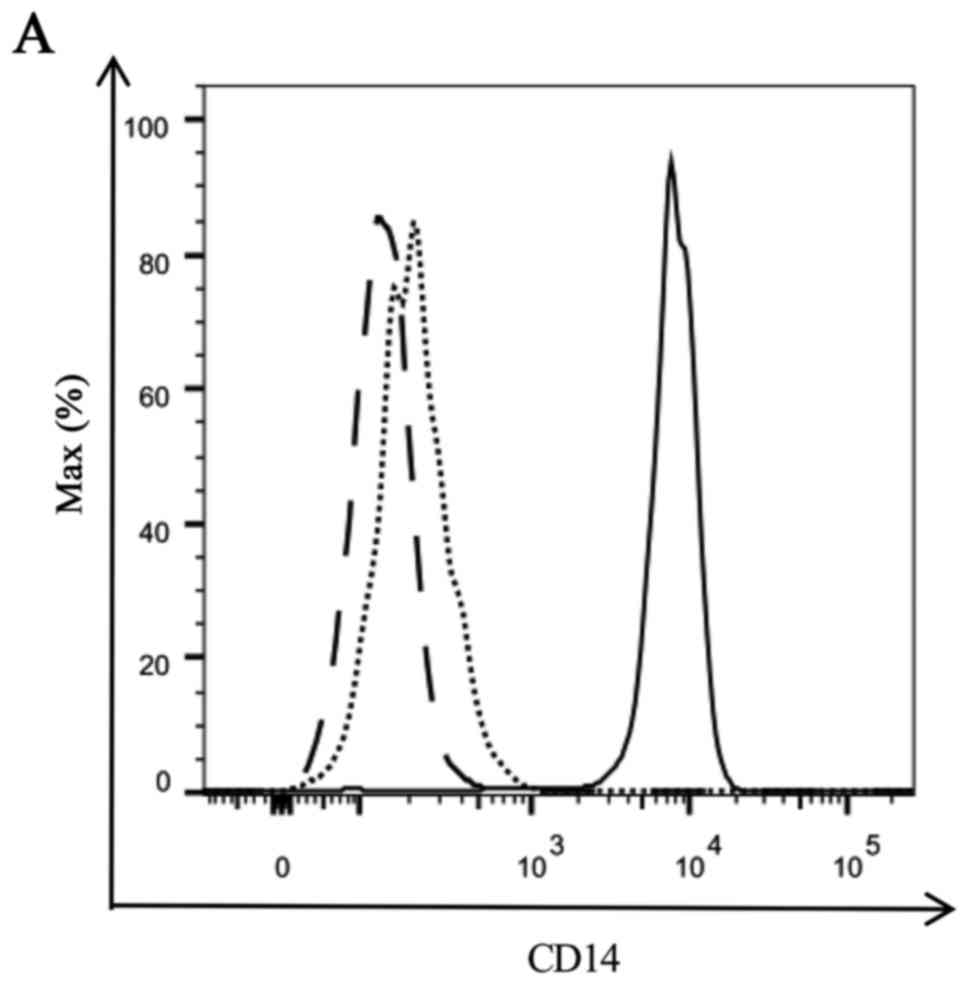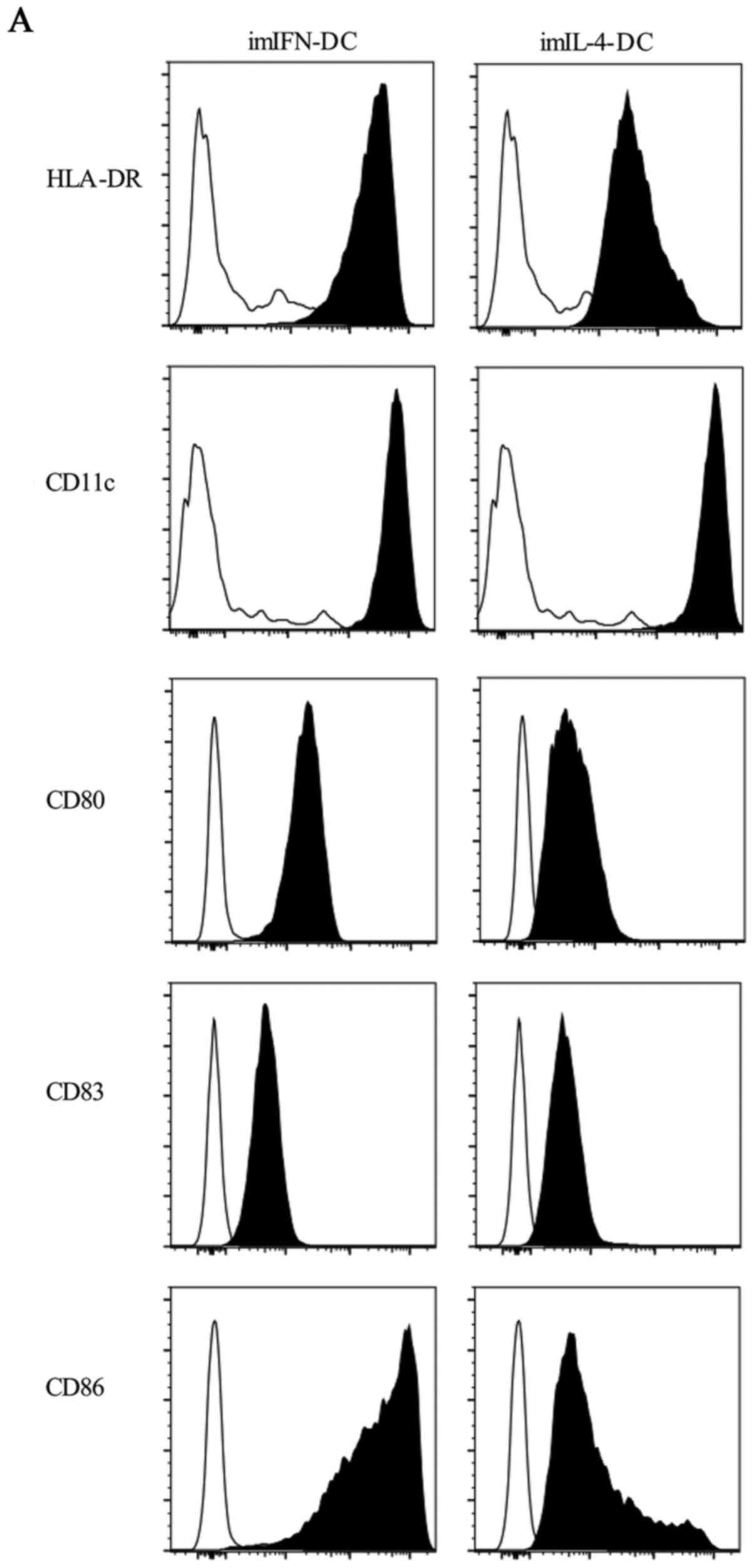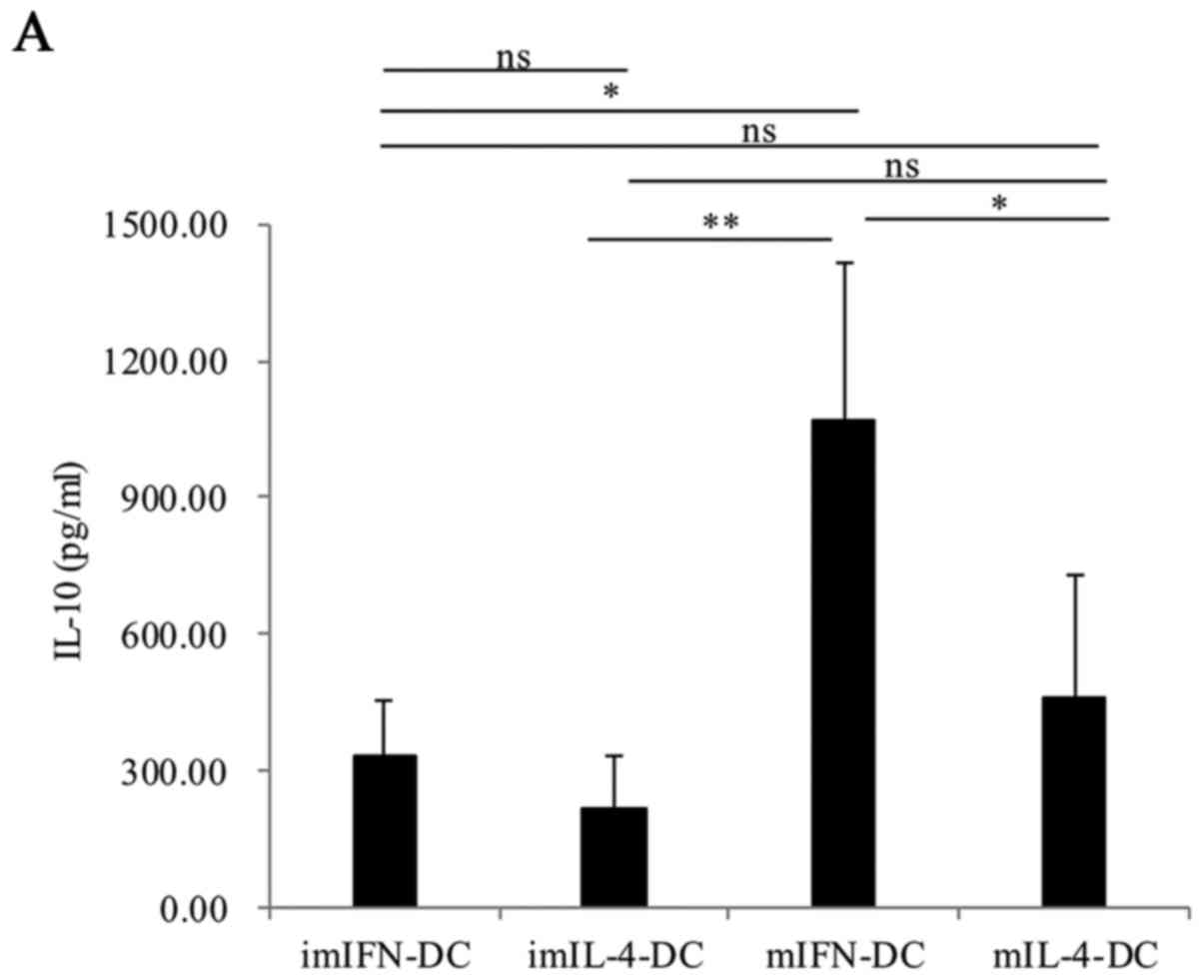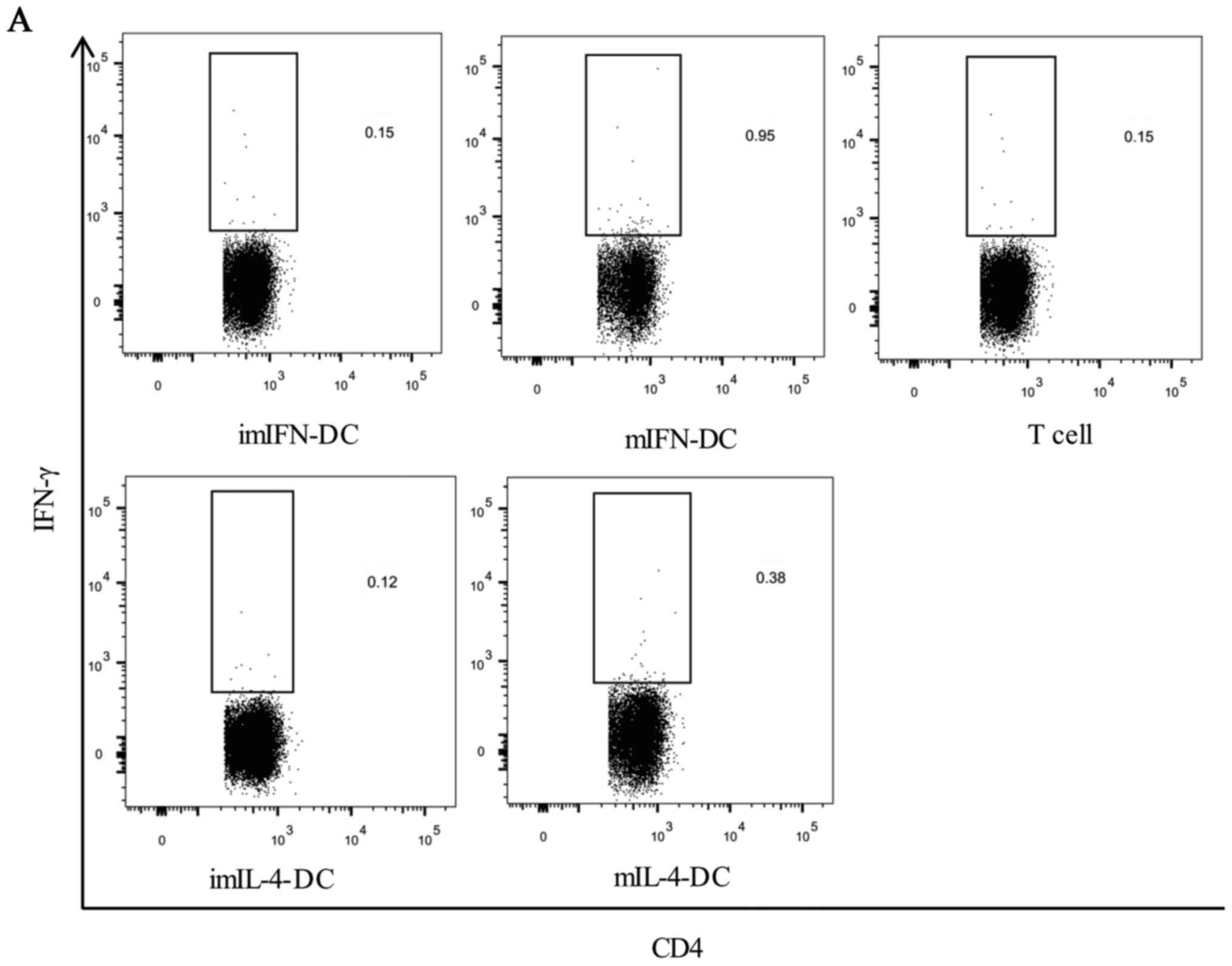|
1
|
Mohty M, Vialle-Castellano A, Nunes JA,
Isnardon D, Olive D and Gaugler B: IFN-alpha skews monocyte
differentiation into Toll-like receptor 7-expressing dendritic
cells with potent functional activities. J Immunol. 171:3385–3393.
2003. View Article : Google Scholar : PubMed/NCBI
|
|
2
|
van Montfoort N, van der Aa E and Woltman
AM: Understanding MHC class I presentation of viral antigens by
human dendritic cells as a basis for rational design of therapeutic
vaccines. Front Immunol. 5:1822014. View Article : Google Scholar : PubMed/NCBI
|
|
3
|
Schreibelt G, Klinkenberg LJ, Cruz LJ,
Tacken PJ, Tel J, Kreutz M, Adema GJ, Brown GD, Figdor CG and de
Vries IJ: The C-type lectin receptor CLEC9A mediates antigen uptake
and (cross-)presentation by human blood BDCA3+ myeloid
dendritic cells. Blood. 119:2284–2292. 2012. View Article : Google Scholar : PubMed/NCBI
|
|
4
|
Sugita S, Kawazoe Y, Imai A, Usui Y,
Iwakura Y, Isoda K, Ito M and Mochizuki M: Mature dendritic cell
suppression by IL-1 receptor antagonist on retinal pigment
epithelium cells. Invest Ophthalmol Vis Sci. 54:3240–3249. 2013.
View Article : Google Scholar : PubMed/NCBI
|
|
5
|
Kim SW, Choi SM, Choo YS, Kim IK, Song BW
and Kim HS: Flt3 ligand induces monocyte proliferation and enhances
the function of monocyte-derived dendritic cells in vitro. J Cell
Physiol. 230:1740–1749. 2015. View Article : Google Scholar : PubMed/NCBI
|
|
6
|
Gabriele L, Borghi P, Rozera C, Sestili P,
Andreotti M, Guarini A, Montefusco E, Foà R and Belardelli F:
IFN-alpha promotes the rapid differentiation of monocytes from
patients with chronic myeloid leukemia into activated dendritic
cells tuned to undergo full maturation after LPS treatment. Blood.
103:980–987. 2004. View Article : Google Scholar : PubMed/NCBI
|
|
7
|
Paquette RL, Hsu NC, Kiertscher SM, Park
AN, Tran L, Roth MD and Glaspy JA: Interferon-alpha and
granulocyte-macrophage colony-stimulating factor differentiate
peripheral blood monocytes into potent antigen-presenting cells. J
Leukoc Biol. 64:358–367. 1998.PubMed/NCBI
|
|
8
|
Lapenta C, Santini SM, Logozzi M, Spada M,
Andreotti M, Di Pucchio T, Parlato S and Belardelli F: Potent
immune response against HIV-1 and protection from virus challenge
in hu-PBL-SCID mice immunized with inactivated virus-pulsed
dendritic cells generated in the presence of IFN-alpha. J Exp Med.
198:361–367. 2003. View Article : Google Scholar : PubMed/NCBI
|
|
9
|
Rizza P, Moretti F, Capone I and
Belardelli F: Role of type I interferon in inducing a protective
immune response: Perspectives for clinical applications. Cytokine
Growth Factor Rev. 26:195–201. 2015. View Article : Google Scholar : PubMed/NCBI
|
|
10
|
Spadaro F, Lapenta C, Donati S, Abalsamo
L, Barnaba V, Belardelli F, Santini SM and Ferrantini M: IFN-alpha
enhances cross-presentation in human dendritic cells by modulating
antigen survival, endocytic routing, and processing. Blood.
119:1407–1417. 2012. View Article : Google Scholar : PubMed/NCBI
|
|
11
|
Carbonneil C, Aouba A, Burgard M,
Cardinaud S, Rouzioux C, Langlade-Demoyen P and Weiss L: Dendritic
cells generated in the presence of granulocyte-macrophage
colony-stimulating factor and IFN-alpha are potent inducers of
HIV-specific CD8 T cells. AIDS. 17:1731–1740. 2003. View Article : Google Scholar : PubMed/NCBI
|
|
12
|
Lapenta C, Santini SM, Spada M, Donati S,
Urbani F, Accapezzato D, Franceschini D, Andreotti M, Barnaba V and
Belardelli F: IFN-alpha-conditioned dendritic cells are highly
efficient in inducing cross-priming CD8(+) T cells against
exogenous viral antigens. Eur J Immunol. 36:2046–2060. 2006.
View Article : Google Scholar : PubMed/NCBI
|
|
13
|
Pilon C, Levast B, Meurens F, Le Vern Y,
Kerboeuf D, Salmon H, Velge-Roussel F, Lebranchu Y and Baron C:
CD40 engagement strongly induces CD25 expression on porcine
dendritic cells and polarizes the T cell immune response toward
Th1. Mol Immunol. 46:437–447. 2009. View Article : Google Scholar : PubMed/NCBI
|
|
14
|
Korthals M, Safaian N, Kronenwett R,
Maihöfer D, Schott M, Papewalis C, Blanco E Diaz, Winter M, Czibere
A, Haas R, et al: Monocyte derived dendritic cells generated by
IFN-alpha acquire mature dendritic and natural killer cell
properties as shown by gene expression analysis. J Transl Med.
5:462007. View Article : Google Scholar : PubMed/NCBI
|
|
15
|
McRae BL, Nagai T, Semnani RT, van
Seventer JM and van Seventer GA: Interferon-alpha and -beta inhibit
the in vitro differentiation of immunocompetent human dendritic
cells from CD14(+) precursors. Blood. 96:210–217. 2000.PubMed/NCBI
|
|
16
|
Lapenta C, Donati S, Spadaro F, Castaldo
P, Belardelli F, Cox MC and Santini SM: NK cell activation in the
antitumor response induced by IFN-α dendritic cells loaded with
apoptotic cells from follicular lymphoma patients. J Immunol.
197:795–806. 2016. View Article : Google Scholar : PubMed/NCBI
|
|
17
|
Chabot V, Martin L, Meley D, Sensebé L,
Baron C, Lebranchu Y, Dehaut F and Velge-Roussel F: Unexpected
impairment of TNF-α-induced maturation of human dendritic cells in
vitro by IL-4. J Transl Med. 14:932016. View Article : Google Scholar : PubMed/NCBI
|
|
18
|
Farkas A, Tonel G and Nestle FO:
Interferon-alpha and viral triggers promote functional maturation
of human monocyte-derived dendritic cells. Br J Dermatol.
158:921–929. 2008. View Article : Google Scholar : PubMed/NCBI
|
|
19
|
Santini SM, Lapenta C, Donati S, Spadaro
F, Belardelli F and Ferrantini M: Interferon-α-conditioned human
monocytes combine a Th1-orienting attitude with the induction of
autologous Th17 responses: Role of IL-23 and IL-12. PLoS One.
6:e173642011. View Article : Google Scholar : PubMed/NCBI
|
|
20
|
Trinchieri G: Interleukin-12 and the
regulation of innate resistance and adaptive immunity. Nat Rev
Immunol. 3:133–146. 2003. View Article : Google Scholar : PubMed/NCBI
|
|
21
|
Askenase MH, Han SJ, Byrd AL, da Fonseca
Morais D, Bouladoux N, Wilhelm C, Konkel JE, Hand TW,
Lacerda-Queiroz N, Su XZ, et al: Bone-marrow-resident NK cells
prime monocytes for regulatory function during infection. Immunity.
42:1130–1142. 2015. View Article : Google Scholar : PubMed/NCBI
|
|
22
|
Childs BG, Baker DJ, Wijshake T, Conover
CA, Campisi J and van Deursen JM: Senescent intimal foam cells are
deleterious at all stages of atherosclerosis. Science. 354:472–477.
2016. View Article : Google Scholar : PubMed/NCBI
|
|
23
|
Oehler L, Majdic O, Pickl WF, Stöckl J,
Riedl E, Drach J, Rappersberger K, Geissler K and Knapp W:
Neutrophil granulocyte-committed cells can be driven to acquire
dendritic cell characteristics. J Exp Med. 187:1019–1028. 1998.
View Article : Google Scholar : PubMed/NCBI
|
|
24
|
Farkas A and Kemény L: Interferon-α in the
generation of monocyte-derived dendritic cells: recent advances and
implications for dermatology. Br J Dermatol. 165:247–254. 2011.
View Article : Google Scholar : PubMed/NCBI
|
|
25
|
Wang S, Sun X, Zhou H, Zhu Z, Zhao W and
Zhu C: Interleukin-4 affects the mature phenotype and function of
rat bone marrow-derived dendritic cells. Mol Med Rep. 12:233–237.
2015. View Article : Google Scholar : PubMed/NCBI
|
|
26
|
Gessani S, Conti L, Del Cornò M and
Belardelli F: Type I interferons as regulators of human antigen
presenting cell functions. Toxins (Basel). 6:1696–1723. 2014.
View Article : Google Scholar : PubMed/NCBI
|
|
27
|
Guenova E, Skabytska Y, Hoetzenecker W,
Weindl G, Sauer K, Tham M, Kim KW, Park JH, Seo JH, Ignatova D, et
al: IL-4 abrogates T(H)17 cell-mediated inflammation by selective
silencing of IL-23 in antigen-presenting cells. Proc Natl Acad Sci
USA. 112:2163–2168. 2015; View Article : Google Scholar : PubMed/NCBI
|
|
28
|
Okada S, Han S, Patel ES, Yang LJ and
Chang LJ: STAT3 signaling contributes to the high effector
activities of interleukin-15-derived dendritic cells. Immunol Cell
Biol. 93:461–471. 2015. View Article : Google Scholar : PubMed/NCBI
|
|
29
|
Taieb A, Breitinger JJ, Unadkat JV,
Shufesky WJ, Morelli AE, Thomson AW, Lee WP and Feili-Hariri M:
Intrinsic ability of GM+IL-4 but not Flt3L-induced rat dendritic
cells to promote allogeneic T cell hyporesponsiveness. Clin
Immunol. 123:176–189. 2007. View Article : Google Scholar : PubMed/NCBI
|
|
30
|
Carbonneil C, Saidi H, Donkova-Petrini V
and Weiss L: Dendritic cells generated in the presence of
interferon-alpha stimulate allogeneic CD4+ T-cell
proliferation: Modulation by autocrine IL-10, enhanced T-cell
apoptosis and T regulatory type 1 cells. Int Immunol. 16:1037–1052.
2004. View Article : Google Scholar : PubMed/NCBI
|
|
31
|
Bella S Della, Nicola S, Riva A, Biasin M,
Clerici M and Villa ML: Functional repertoire of dendritic cells
generated in granulocyte macrophage-colony stimulating factor and
interferon-alpha. J Leukoc Biol. 75:106–116. 2004. View Article : Google Scholar : PubMed/NCBI
|
|
32
|
Papewalis C, Jacobs B, Wuttke M, Ullrich
E, Baehring T, Fenk R, Willenberg HS, Schinner S, Cohnen M,
Seissler J, et al: IFN-alpha skews monocytes into
CD56+-expressing dendritic cells with potent functional
activities in vitro and in vivo. J Immunol. 180:1462–1470. 2008.
View Article : Google Scholar : PubMed/NCBI
|
|
33
|
Fujii S, Liu K, Smith C, Bonito AJ and
Steinman RM: The linkage of innate to adaptive immunity via
maturing dendritic cells in vivo requires CD40 ligation in addition
to antigen presentation and CD80/86 costimulation. J Exp Med.
199:1607–1618. 2004. View Article : Google Scholar : PubMed/NCBI
|
|
34
|
Freeman GJ, Gribben JG, Boussiotis VA, Ng
JW, Restivo VA Jr, Lombard LA, Gray GS and Nadler LM: Cloning of
B7-2: A CTLA-4 counter-receptor that costimulates human T cell
proliferation. Science. 262:909–911. 1993. View Article : Google Scholar : PubMed/NCBI
|
|
35
|
Evans EJ, Esnouf RM, Manso-Sancho R,
Gilbert RJ, James JR, Yu C, Fennelly JA, Vowles C, Hanke T, Walse
B, et al: Crystal structure of a soluble CD28-Fab complex. Nat
Immunol. 6:271–279. 2005. View
Article : Google Scholar : PubMed/NCBI
|
|
36
|
Pentcheva-Hoang T, Egen JG, Wojnoonski K
and Allison JP: B7-1 and B7-2 selectively recruit CTLA-4 and CD28
to the immunological synapse. Immunity. 21:401–413. 2004.
View Article : Google Scholar : PubMed/NCBI
|
|
37
|
Lenschow DJ, Walunas TL and Bluestone JA:
CD28/B7 system of T cell costimulation. Annu Rev Immunol.
14:233–258. 1996. View Article : Google Scholar : PubMed/NCBI
|
|
38
|
Leplina OY, Tyrinova TV, Tikhonova MA,
Ostanin AA and Chernykh ER: Interferon alpha induces generation of
semi-mature dendritic cells with high pro-inflammatory and
cytotoxic potential. Cytokine. 71:1–7. 2015. View Article : Google Scholar : PubMed/NCBI
|
|
39
|
van Lummel M, van Veelen PA, de Ru AH,
Janssen GM, Pool J, Laban S, Joosten AM, Nikolic T, Drijfhout JW,
Mearin ML, et al: Dendritic cells guide islet autoimmunity through
a restricted and uniquely processed peptidome presented by
high-risk HLA-DR. J Immunol. 196:3253–3263. 2016. View Article : Google Scholar : PubMed/NCBI
|
|
40
|
Foster GA, Xu L, Chidambaram AA, Soderberg
SR, Armstrong EJ, Wu H and Simon SI: CD11c/CD18 signals very late
antigen-4 activation to initiate foamy monocyte recruitment during
the onset of hypercholesterolemia. J Immunol. 195:5380–5392. 2015.
View Article : Google Scholar : PubMed/NCBI
|
|
41
|
Arnold IC, Mathisen S, Schulthess J, Danne
C, Hegazy AN and Powrie F: CD11c(+) monocyte/macrophages promote
chronic Helicobacter hepaticus-induced intestinal inflammation
through the production of IL-23. Mucosal Immunol. 9:352–363. 2016.
View Article : Google Scholar : PubMed/NCBI
|
|
42
|
Banchereau J, Pascual V and O'Garra A:
From IL-2 to IL-37: The expanding spectrum of anti-inflammatory
cytokines. Nat Immunol. 13:925–931. 2012. View Article : Google Scholar : PubMed/NCBI
|
|
43
|
Yoshimoto T, Takeda K, Tanaka T, Ohkusu K,
Kashiwamura S, Okamura H, Akira S and Nakanishi K: IL-12
up-regulates IL-18 receptor expression on T cells, Th1 cells, and B
cells: Synergism with IL-18 for IFN-gamma production. J Immunol.
161:3400–3407. 1998.PubMed/NCBI
|
|
44
|
Behzadi P, Behzadi E and Ranjbar R: IL-12
family cytokines: General characteristics, pathogenic
microorganisms, receptors and signalling pathways. Acta Microbiol
Immunol Hung. 63:1–25. 2016. View Article : Google Scholar : PubMed/NCBI
|
|
45
|
Vignali DA and Kuchroo VK: IL-12 family
cytokines: Immunological playmakers. Nat Immunol. 13:722–728. 2012.
View Article : Google Scholar : PubMed/NCBI
|
|
46
|
Belladonna ML, Renauld JC, Bianchi R,
Vacca C, Fallarino F, Orabona C, Fioretti MC, Grohmann U and
Puccetti P: IL-23 and IL-12 have overlapping, but distinct, effects
on murine dendritic cells. J Immunol. 168:5448–5454. 2002.
View Article : Google Scholar : PubMed/NCBI
|
|
47
|
de Niet A, Stelma F, Jansen L, Sinnige MJ,
Remmerswaal EB, Takkenberg RB, Kootstra NA, Reesink HW, van Lier RA
and van Leeuwen EM: Restoration of T cell function in chronic
hepatitis B patients upon treatment with interferon based
combination therapy. J Hepatol. 64:539–546. 2016. View Article : Google Scholar : PubMed/NCBI
|
|
48
|
Aarntzen EH, De Vries IJ, Lesterhuis WJ,
Schuurhuis D, Jacobs JF, Bol K, Schreibelt G, Mus R, De Wilt JH,
Haanen JB, et al: Targeting CD4(+) T-helper cells improves the
induction of antitumor responses in dendritic cell-based
vaccination. Cancer Res. 73:19–29. 2013. View Article : Google Scholar : PubMed/NCBI
|



